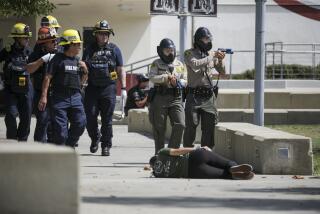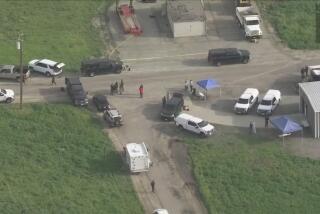Mock Terrorist Gas Attack Tests San Diego Forces
SAN DIEGO — The goal of Thursday’s exercise was to conjure up one of the ghastliest scenarios of the modern age: the pain, panic and death that can be spread by terrorists who strike without warning and without mercy.
Coordinated by the FBI and the Defense Department, Operation Grand Slam brought hundreds of firefighters, paramedics, rescue personnel and police racing to Qualcomm Stadium on Thursday in response to a simulated attack of sarin, the odorless and colorless nerve gas that killed 12 people in a Tokyo subway in 1995 in an attack launched by a religious cult.
While the military has long trained to react to terrorist acts, only recently has training been expanded to cover the civilian population.
Since 1997, the United States has spent more than $153 million under the Domestic Preparedness Program Act to prepare federal, state and local emergency personnel for incidents involving nuclear, biological and chemical terrorism.
The act was passed by Congress in the wake of the Tokyo attack and the 1993 bombing of the World Trade Center.
The twin horrors convinced legislators that the nation was woefully ill-prepared to handle mass casualties likely to be inflicted by an attack on a major work site or communal recreational venue such as a stadium. President Clinton has opined that a terrorist attack is likely within a decade.
Under the 1997 act, more than 50 cities have held drills similar to Thursday’s, although few have been as large or complex. The act has also financed increased intelligence-gathering on potential terrorists.
While there are no indications that an attack is imminent, San Diego’s high-rises, military installations and tourist sites could be perversely attractive to someone of evil intent, officials said.
“The San Diego region is a target-rich environment,” said FBI Special Agent John Sylvester, terrorist specialist in the bureau’s San Diego office.
For emergency personnel who spend their days and nights responding mostly to 911 calls involving traffic accidents, knife and gun incidents, and cliff rescues, Thursday’s exercise, and the two years of training that preceded it, was a kind of reality check.
“We want all our first-responders talking weapons of mass destruction,” said Ralph Perry, an official with the San Diego County office of disaster preparedness.
Different locales have constructed different scenarios on the theory that terrorists, if nothing else, are unpredictable.
In New York, the drill simulated an attack on a busy street in Greenwich Village. In Portsmouth, N.H., the attack came at the beginning of a 5K run. In Sacramento, the venue was Hornet Stadium, and in Los Angeles last year, the airport in Burbank.
Next month, a drill is set for Edison Field in Anaheim. Stadiums are particularly tricky.
“A stadium is a whole different ballgame,” Sylvester said. “You’ve got wind eddies, you’ve got steep stairs, you’ve got narrow access.”
For “Grand Slam,” the role of agonized victims was played by Marines, sailors and Explorer Scouts. Part of the assignment was to be uncooperative and, if possible, hysterical as firefighters and paramedics were assessing, decontaminating the treating the injured.
“We don’t need any more [bleeping] water, we need a doctor,” screamed one young Marine as a firefighter doused him and his confreres with a shower.
Role-playing is a seductive thing, however, and Craig Deatley, a Defense Department program coordinator, thought it prudent to warn the faux victims to avoid fisticuffs, “At no times are you to use your hands to reinforce your message.”
In Philadelphia, one role-player got carried away and ended up being charged, and convicted, of assault. “He remains the only American ever arrested at a Domestic Preparedness Drill,” Deatley said.
In San Francisco, an out-of-work actor played his role so convincingly that three on-scene doctors believed he had suffered a real seizure.
In October, responsibility for the program shifts from the Defense Department to the Justice Department, with funding and direction yet to be decided. At the Defense Department, the program has been run by the Army Soldier and Biological Chemical Command at Aberdeen Proving Ground, Md.
Thursday’s session is what is called a “train the trainer” exercise, in which it is hoped that the word will be spread later to troops who were not present.
“We recognize our vulnerability,” said San Diego Deputy Fire Chief D.P. Lee. “Terrorism is out there.”
More to Read
Sign up for Essential California
The most important California stories and recommendations in your inbox every morning.
You may occasionally receive promotional content from the Los Angeles Times.










